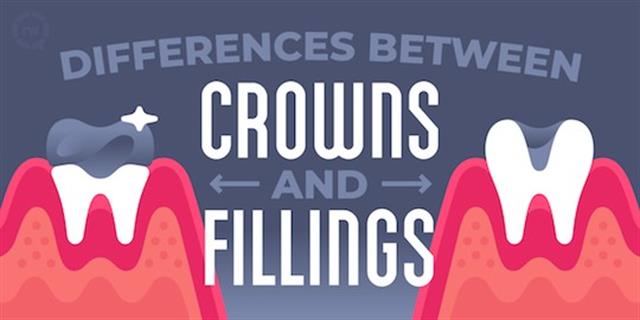
It’s normal to be confused about dental terminology. Unless you’re in the profession yourself, it can be easier to smile and nod while in the chair than ask about all the ins and outs of any procedure recommended to you.
If you’ve always been curious, however, about the difference between the two most common treatments for tooth decay – crowns and fillings – then we will fill you in. Pun intended!
First, let’s give you a brief reason why you would need a crown or a filling: tooth decay. It happens, sadly. Acid (from food or from bacteria) wears away at your tooth enamel and creates a hole where bacteria can enter and make their home. Left alone, tooth decay will only get worse, be extremely painful, and be expensive to treat.
Fillings and crowns are your dentist’s first lines of defense to prevent further tooth decay.
What is a filling?
A filling is used to replace the decayed substance in your tooth where a cavity has formed. Your dentist will remove the decayed part of the tooth, clean out the cavity, and then place a filling to fill the void. This returns the tooth to a usable shape and structure and aims to prevent further tooth decay.
There are different materials that compose fillings. Some are made out of gold, some out of a silver amalgam, and others out of tooth-colored composite resins or porcelain. These materials vary in durability and function. The type of material used for a filling depends on the extent of the tooth damage, what type of tooth it is, and other unique factors.
Generally, fillings are used to repair small amounts of damage within a tooth.
What is a crown?
A crown (also referred to as a “cap”) may be necessary for teeth with greater amounts of decay or if a tooth is chipped or broken. A crown can also be used to cover teeth that are misshapen or discolored. It’s basically a cover for an existing tooth. It covers the entire portion of your tooth that extends above the gumline (the portion that can be seen).
The procedure involves taking an impression of your tooth, which can be done digitally or with a physical tray you sink your teeth into. Then, a crown is created that fits your tooth and is placed over it, appearing from the outside with a normal shape.
Crowns are made out of different materials such as metal alloys, ceramics, composite resin, or a combination of these.
It’s important to know ...
Both fillings and crowns are subject to wear and tear over time and may need to be replaced after several years or decades.
Your dentist will suggest the best treatment for your situation. Knowing whether to use a filling or a crown involves considering the severity of your tooth decay, your health, and other factors. The best thing you can do to protect the health of your mouth is keep up with daily brushing and flossing, and visiting your dentist for routine visits!
